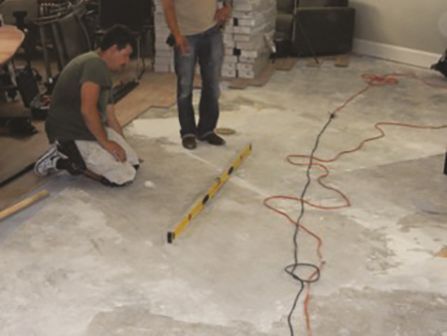Imagine this: You’re standing in a bustling restaurant kitchen, the air filled with the tantalizing aroma of sizzling food and the clanging of pots and pans. You spot a chef deftly chopping vegetables, his movements precise and confident. But wait, what’s that beneath his feet? A cracked, chipped tile floor, its surface a breeding ground for bacteria and a source of potential slips and falls. This scenario highlights a critical issue: the importance of choosing the right flooring for food preparation areas.

Image: vancouverflooringcompany.com
The flooring in a kitchen, particularly in the prep area, is not just about aesthetics. It’s a cornerstone of food safety and hygiene. Think of it as the invisible guardian of your health, safeguarding you from harmful bacteria and ensuring a clean and secure environment for food preparation. In this article, we’ll delve into the essential criteria for choosing flooring in prep areas, exploring materials, durability, and hygiene considerations. We’ll also discuss industry best practices and tips for making informed decisions.
A Floor With Substance: The Essentials for Prep Area Flooring
The right flooring in a prep area is more than just a pleasing aesthetic; it’s a crucial component of safety and sanitation. When choosing flooring, consider the following key factors:
1. Durability and Resilience:
- High Traffic Zones: Food prep areas experience a constant churn of activity, with foot traffic, heavy equipment, spills, and potential drops. The flooring must be resistant to scratches, dents, and abrasion, able to withstand the daily wear and tear.
- Temperature Fluctuations: Kitchen environments can be subject to temperature swings, from the heat of ovens to the chilling presence of refrigerators. Flooring needs to be able to handle these shifts without cracking, warping, or becoming slippery.
2. Hygienic Integrity:
- Non-Porous Surfaces: Bacteria thrive in cracks, crevices, and porous materials. Opt for flooring that is non-porous, meaning it doesn’t have gaps or holes where bacteria can hide.
- Easy to Clean: Prep areas require regular sanitization. Look for flooring that is easy to clean and disinfect, resistant to staining and discoloration.
- Antimicrobial Properties: Some flooring materials offer additional protection with antimicrobial properties that inhibit bacterial growth.
3. Slip Resistance:
- Wet Environments: Prep areas often experience spills and splashes, leading to wet surfaces. The flooring should have a slip-resistant finish to prevent accidents.
- Grits and Textures: Look for floors with textured surfaces or anti-slip finishes that add grip without compromising on cleanability.
4. Aesthetic Considerations:
- Visual Appeal: Though less important than safety and hygiene, the visual appeal of the floor matters. Choose a color and texture that complement the overall kitchen design, promoting a clean and inviting atmosphere.
Flooring Options: The Pros and Cons of Popular Choices
Now let’s explore some of the most popular flooring choices for food prep areas, examining their benefits and drawbacks:
1. Ceramic Tile:
- Pros: Durable, resistant to scratches and stains, easy to clean, wide variety of colors and patterns.
- Cons: Can be cold and hard underfoot, prone to cracking if not properly installed, susceptible to chipping and scratches.
2. Porcelain Tile:
- Pros: Extremely durable, resistant to heat and moisture, impervious to stains, easy to clean.
- Cons: Can be expensive, prone to chipping around edges, can be cold and hard underfoot.
3. Epoxy Coatings:
- Pros: Durable, seamless, resistant to chemicals and stains, easy to clean, can be applied to existing flooring.
- Cons: Limited aesthetic options, can be slippery if not installed properly.
4. Rubber Flooring:
- Pros: Comfortable underfoot, noise-absorbing, slip-resistant, highly durable, excellent in wet areas.
- Cons: Can be more expensive than other options, susceptible to staining.
5. Vinyl Flooring:
- Pros: Budget-friendly, easy to install, wide variety of colors and patterns, easily maintained.
- Cons: Can be prone to scratches and wear, limited water resistance, may be less durable than other options.
Expert Advice: Making Informed Decisions
Here are a few key pieces of advice from food safety experts and flooring professionals:
- Consulting an Expert: If you’re unsure about the best flooring choice for your kitchen, consult a commercial flooring specialist or a food safety consultant. They can provide tailored recommendations based on your needs, budget, and specific kitchen environment.
- Maintenance Matters: The best floor is only as good as its maintenance. Develop a regular cleaning and sanitizing schedule to keep the floor clean and safe.
- Invest in Quality: While budget-friendly options may seem tempting, investing in high-quality flooring can save you money and headaches in the long run.

Image: www.deserthardwoodflooring.com
All Flooring In Prep Areas Must Be
The Lasting Impact of Safe and Hygienic Flooring
The right flooring in food preparation areas isn’t just about aesthetics or durability; it’s about safeguarding the health of your customers and employees. By making informed choices, you create a food-safe environment that fosters confidence, promotes hygiene, and ensures a positive experience for everyone. With a focus on safety, cleanability, and durability, you’ll not only create a beautiful kitchen, but also a responsible and reliable space for preparing delicious and safe food.
Now that you’re armed with knowledge about choosing the perfect flooring for your food prep area, you can confidently take the next steps. If you’re in the process of designing or renovating a kitchen, consider these insights as you create a space that prioritizes health, hygiene, and a consistently positive experience for your customers. So, go forth and build a kitchen that you, your staff, and your customers can be proud of!






